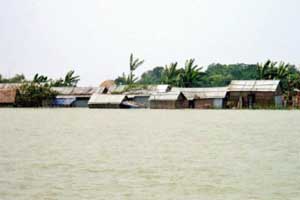The post Flood: Some positive effects appeared first on Dhaka Mirror.
]]> Flood is overflow of huge amount of water on the normally dry land. The EU flood directive defines flood as ‘a temporary covering by water of land not normally covered by water’. In broader sense, flood can be classified in two types as: natural flood and catastrophic flood. Natural flood is the flood that is caused naturally by the overflow of huge volume of water from rivers, lakes, oceans, or by heavy rains, etc. On the other hand catastrophic flood is the flood that is caused by some significant and unexpected events, for example dam breaching, cyclones, etc. In Bangladesh both types of floods are observed. But heavy rainfall is one of the major causes of floods in Bangladesh. When the level of water in rivers or lakes rises due to heavy rainfalls, at some point it spills over the river banks or dams causing flood.
Flood is overflow of huge amount of water on the normally dry land. The EU flood directive defines flood as ‘a temporary covering by water of land not normally covered by water’. In broader sense, flood can be classified in two types as: natural flood and catastrophic flood. Natural flood is the flood that is caused naturally by the overflow of huge volume of water from rivers, lakes, oceans, or by heavy rains, etc. On the other hand catastrophic flood is the flood that is caused by some significant and unexpected events, for example dam breaching, cyclones, etc. In Bangladesh both types of floods are observed. But heavy rainfall is one of the major causes of floods in Bangladesh. When the level of water in rivers or lakes rises due to heavy rainfalls, at some point it spills over the river banks or dams causing flood.Flood is always a damaging and devastating disaster for Bangladesh. As it is a very low-lying country with 70% of its land less than 1m above sea level and 80% of it floodplains. The country receives large amounts of water passing through it by two major rivers (the Ganges and Brahmaputra) converging with tributaries on the huge delta formed from silt deposited by the same rivers as they entered the sea. Both rivers have large volumes of water flowing through them to the sea as they have large drainage basins which increase the flood risk.
Bangladesh has a monsoon climate and the annual torrential rains result in annual flooding. In addition, during spring, melting snow from the Himalayas further increases the flood risks as torrents of water enter the rivers at their source. Consequently the country experienced tragedy of flood in 1987, 1988, 1998, 2004 and 2007.
It is well known that flood is the part of natural cycle and it has got both positive and negative impact on the environment. The negative impact of flood is very much understandable to all but the positive impact is still relatively unfamiliar. So, in this article the writer likes to focus on the positive effect of flood.
Although flood can be devastating to the people, it has always been an essential part of nature’s renewal process, providing many long-term positive effects as the following:
Revives ground water: Many countries like Bangladesh depend on ground water and underground aquifers for fresh water. Floodwaters absorb into the ground and infiltrates down through the rock to recharge these underground aquifers that supply natural springs, wells, rivers and lakes with fresh water.
Renews the wetlands: Flood balances the health of ecology of the wetlands. Healthy wetlands promote healthy water supplies and improve the surrounding air quality. Flood contributes fresh water and waste to the wetlands that carry and deposit nutrient-rich sediments that support both plant and animal life of the wetlands.
Returns nutrients to soil: Flood distributes and deposits river sediments over large areas of land. These river sediments replenish nutrients in topsoil and make agricultural lands more fertile. The populations of many ancient civilizations concentrated along the floodplains of rivers such as the Nile, the Tigris and the Yellow because periodic flooding resulted in fertile, productive farmlands.
Recovers natural fish stock: Flood can provide fresh water, waste, nutrients and larva to the wetlands. As a result the wetlands get chance to renew its environment. It helps to recover the natural fish stock and increase the population of fishes. Flood also adds nutrients to lakes and streams that help support healthy fisheries.
Works on anoxia and hypoxia of wetlands: A variety of physical, chemical and biological changes occur in floodwater. Because of high currents, waste accumulation minimized by hydrodynamic spreading and water movement also helps to replenish anoxic (absence of oxygen) or hypoxia (low level of oxygen) water with oxygen-rich water from enormous flooding and upgrade the environment.
Prevents erosion and maintains land mass elevation: Soil deposited by floodwaters prevents erosion and helps maintain the elevation of landmasses above sea level. The rapidly receding land of the Mississippi River delta is a direct result of man-made flood controls and levees that prevent topsoil-replenishing sediments from being deposited in the delta.
Other effects: Flood brings fresh water for irrigation and domestic use, increases fishery resources, improves navigation of transport, kills insect, washes out acid water, pushes salt water toward the sea, etc.
Flood is certainly natural calamity but still it is the only disaster that brings some positive effect to the environment. It is never liked to be flooded but flood can revive and refresh the nature by its own law.
(Article originally published on The Daily Star)
The writer is an environmental geologist. mohiuddin.envgeo@gmail.com
The post Flood: Some positive effects appeared first on Dhaka Mirror.
]]>